




Learning More about Our Ecosystem
An ecosystem is formed by the interactions of all living species with each other and with the physical and chemical aspects of their environment, linked by the flow of energy. It consists of all of the living things in a particular area, as well as their nonliving surroundings like air, water, and sunlight. Humans rely on ecosystems for basic needs. Ecosystems keep us alive by providing clean water and fresh food. They provide raw materials to satisfy our needs for clothing, shelter, transportation, and energy.
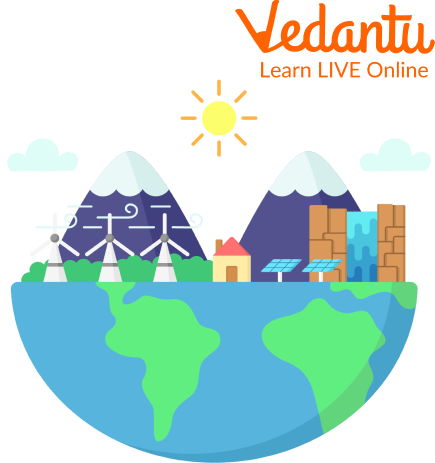
Ecosystem Diagram
What is an Ecosystem?
An ecosystem can be defined as the biological community of living beings, communicating with their environment and other non-living components. Every living thing, including man, is involved in these complex networks of interdependent relationships, which are called ecosystems.
Structure of the Ecosystem
The structure of an ecosystem is defined by the association of both biotic and abiotic components of the ecosystem. This encompasses the percentage of energy in our environment. The structure of an ecosystem can be divided into two main elements, namely: biotic and abiotic components. Let’s learn about these in detail.
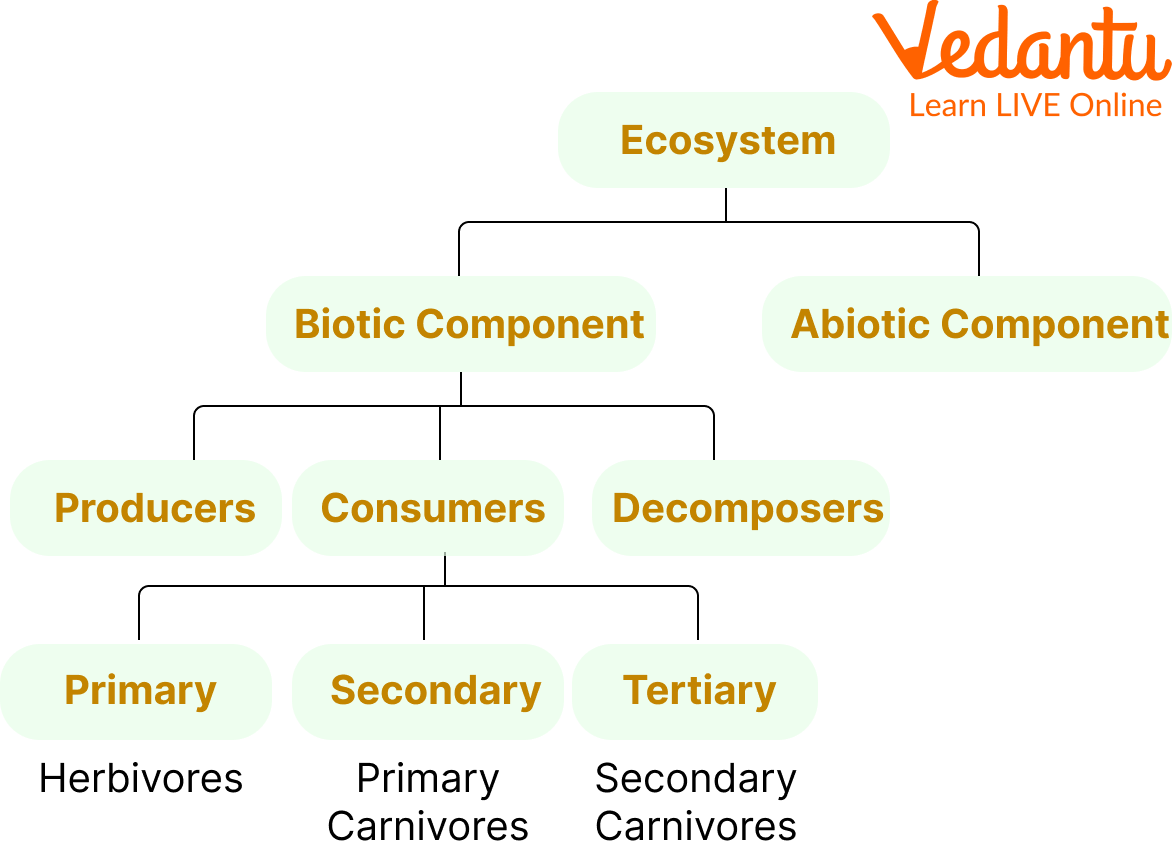
Structure of Ecosystem
1. Biotic Components of the Ecosystem
Nutrition classifies biotic components as autotrophs, heterotrophs, or saprotrophs (or decomposers).
All autotrophs, such as plants, are producers. They are called autotrophs because they can create food through photosynthesis. As a result, all species higher up the food chain rely on producers for sustenance.
Saprophytes such as fungi and bacteria are decomposers. They feed directly on dead and decaying organic substances. Decomposers are important for the ecology because they recycle nutrients that plants can utilise.
Consumers, also known as heterotrophs, are organisms that rely on other organisms for sustenance. Consumers are further subdivided into primary, secondary, and tertiary consumers. As they rely on producers for food, primary consumers are always herbivores.
Primary consumers provide energy to secondary consumers. They can be carnivorous or omnivorous.
Tertiary consumers are creatures that get their sustenance from secondary consumers. Tertiary consumers can be either carnivorous or omnivorous.
Some food chains contain quaternary consumers. For energy, these organisms prey on tertiary consumers. Furthermore, they are frequently at the top of a food chain because they have no natural predators.
2. Abiotic Components of the Ecosystem
It consists of both basic inorganic (soil, water, oxygen, calcium carbonates, phosphates, and so on) and organic components. Physical elements such as moisture, wind currents, and solar radiation are also included. The sun's radiant energy is the only important energy source for any biosphere.
Types of Ecosystem
An ecosystem might be as little as a desert oasis or as large as an ocean stretching thousands of kilometres. Ecosystems are classified into two types:
1. Terrestrial Ecosystem
Terrestrial ecosystems are the type of ecosystems that are mostly found on land. Terrestrial ecosystems encompass around 140 to 150 million km sq. or approximately 25 to 30% of the entire earth's surface area.
There are several types of terrestrial ecosystems found in diverse geological zones. These are as follows:
Forest: A forest ecosystem is made up of various plants, notably trees, animals, and microorganisms that coexist with the abiotic components of the environment. Forests help to keep the earth's temperature stable and act as a primary carbon sink.
Grasslands: Grass and plants dominate the vegetation in a grassland habitat. Grassland environments include temperate grasslands and tropical or savanna grasslands.
Tundra: Tundra ecosystems are located in freezing climates or where rainfall is limited and are devoid of trees. For the majority of the year, these are covered in snow. Tundra ecosystems can be found in the Arctic or on mountain peaks.
Desert: Deserts can be found all over the planet. These are low-lying areas with little vegetation.
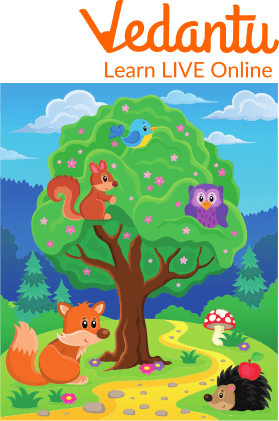
Terrestrial Ecosystem
2. Aquatic Ecosystem
Aquatic ecosystems are ecosystems that exist in bodies of water.
These are further classified into two types:
Freshwater Ecosystem: It is an aquatic ecosystem that includes lakes, ponds, rivers, streams and wetlands. These have no salt content in contrast with the marine ecosystem.
Marine Ecosystem: The marine ecosystem includes seas and oceans. These have a more substantial salt content and more extraordinary biodiversity in comparison to the freshwater ecosystem.
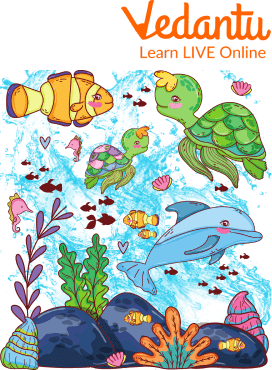
Aquatic Ecosystem
Energy Flow in the Ecosystem
One of the substantial variables that benefit the survival of various creatures is the energy flow in the ecosystem. Sun is the ultimate source of energy for all lives. This energy is used by plants in the process of photosynthesis, which is used to synthesise their food.
Light energy is transformed into chemical energy and transferred down through successive trophic levels during this biological process. The food chain refers to the transfer of energy from a producer to a consumer and finally, to an apex predator or a detritivore. Let us understand with the example of the food chain given below.
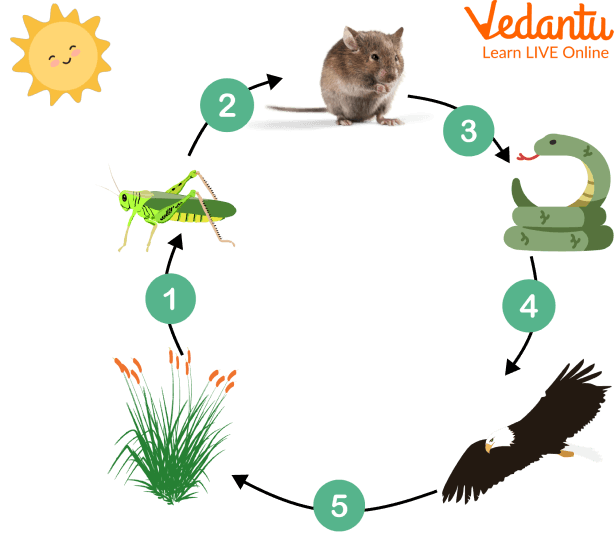
Food Chain
Step 1: The grasshopper eats the plants.
Step 2: The mouse eats the grasshopper.
Step 3: The snake eats the mouse.
Step 4: The eagle eats the snake.
Step 5: When the eagle dies, fungi break down the body and turn them into nutrients.
Summary
From this article on what is the ecosystem for class 7, we have learnt that an ecosystem is a community of living organisms and their physical environment. The term can be used to refer to different areas in the natural world, such as forests, grasslands, and coral reefs. There are two types of ecosystems: one is the terrestrial ecosystems that includes forest, grassland, desert, etc. The second type is an aquatic ecosystem that includes rivers, seas, ponds, etc.
Ecosystems are composed of both biotic (living)that include plants and animals, etc. and abiotic (non-living) components like soil, water, air, etc. which interact with one another to produce the unique characteristics of each ecosystem. The transfer of energy from one organism to the other is known as a food chain which produces energy flow in the ecosystem.
FAQs on Ecosystem
1. What role does the ecosystem play?
The ecosystem plays a variety of important roles in our society, including air purification for comfortable breathing, carbon sequestration for climate regulation, nutrient cycling, so that clean drinking water can be accessed without expensive infrastructure, and crop pollination so that we won't go hungry.
2. What are the functions of the ecosystem?
The following are the functions of the ecosystem:
It regulates critical ecological processes, supports living systems, and provides stability.
It keeps the ecosystem's various trophic levels in balance.
It transports minerals throughout the environment.
3. What ecosystem is the largest?
The largest ecosystem still in existence on earth is the World Ocean. With more than 71% of the earth's surface under it, it provides a living for more than 3 billion people. Additionally, the ocean serves as the primary "lung" of our planet, releasing more oxygen into the atmosphere than all of the world's forests combined and absorbing 30% of the carbon dioxide produced by people!









